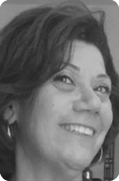
With its main office just a stone’s throw from the White House, Eye Doctors of Washington (EDOW) enjoys prime positioning amid ideal demographics. The DC metro area is home to eight of the 11 US counties with the highest median income, and it has one of the best-educated workforces in the country, with 53% of Washington, DC, residents holding a bachelor’s degree or higher compared to 29% of the US population, according to DC Press’ Washington, DC, Fact Sheet. In addition, says EDOW CEO Roberto Conte, every 2 to 4 years, freshly minted elected officials emerge with their entourage of staffers, and “the town gets an influx of energetic people who are also consumers of health care.”
This dynamic is partially responsible for the 15% annual growth that the practice has enjoyed for the past 5 years, but there are other factors at play. A finely tuned customer service mentality, a firm embrace of social media and digital outreach initiatives, and the establishment of clinical protocols that create a distinct cultural mindset all account for EDOW’s brand recognition and highly regarded reputation throughout the region, according to Paul C. Kang, MD, a partner and cornea, cataract, and refractive surgeon at EDOW. “Washington, DC, is a highly educated community; people do their homework before enlisting the services of a physician,” explains Dr. Kang, who is also an assistant clinical professor in the Department of Ophthalmology at Georgetown University. “They epitomize the type of patients who are looking for the best ways to approach treatment of any of their eye conditions, so we strive to meet that need, and I think that’s what makes us successful.”
EDOW has a distinguished academic pedigree, given that the multispecialty practice was founded half a century ago by a group of professors from the Center for Sight at Georgetown University, but there is nothing of the “ivory tower” about it. When asked to describe the practice in one word, Dr. Kang suggests progressive. “Our patients want the best treatments, so we’re always looking for ways to be innovative, and because of this, we tend to be early adopters of technology,” he says. “For example, we were the first in Washington, DC, to do laser cataract surgery; we were the first in Washington, DC, to implant multifocal intraocular lenses; [and] we were the first in Washington, DC, to do all-laser LASIK. Those are the kinds of initiatives that our patients want and expect. They expect us to be on the forefront—providing the best available options—and are confident that, as other options emerge on the horizon, we will have done our due diligence to either vet it and include it in our practice or exclude it.”
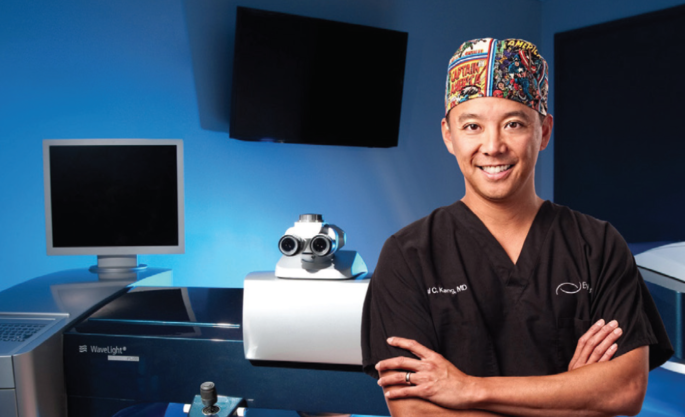
Dr. Kang has been with EDOW for a dozen years and explains that, during his tenure, the practice has grown from two sites to five and from five providers to 11. He adds that, in the past 8 years, it has expanded from 30 employees to 70. “We’ve created a tremendous amount of growth since I’ve been here, and I think a lot of that has to do with our approach,” he remarks. More specifically, says Dr. Kang, it is about patients’ being able to count on EDOW for a consistent approach to treatment and patient services. He says, “We have multiple cornea, cataract, refractive, and glaucoma doctors, and we’re all of the same ilk. Regardless of our training or specialty, we share the same mentality of offering the most innovative, proven best treatments, and I think that resonates with our patients.”
Knowing how to reach these patients is integral to continued success, Dr. Kang explains. “The expectations are so much higher today,” he comments. “Patients are looking for more from their doctor experiences. Now that it’s so easy to do a Web search, and there are so many ways to interact on social media, patients are taking health care and their health care choices into their own hands. This is in contrast to the days when patients went to whoever their primary care physician or insurance carrier recommended. With patients being so involved in choosing their health care providers, it’s imperative to do everything possible to attract them and be ready to meet their needs when they reach out to us.”
In the following interview, Dr. Kang and Mr. Conte delve into the particulars of what makes EDOW the go-to eye care practice in and around the nation’s capital.
CRST: What role does customer service play in EDOW?
Dr. Kang: While we are an academically oriented practice, we are all about customer service and trying to bring the best experience to patients. We bring everything we know about the customer service aspect of treating LASIK patients to all of our patients. When I give the staff examples of what we’re trying to do, I explain that we want to convey the feeling associated with a high-end department store, which is well known for its exemplary customer service. I want patients to associate us with high quality and personal attention.
CRST: How would you describe EDOW?
Mr. Conte: We’re too big to be a small practice, and we’re too small to be a big practice. We’re right in the middle. We are a subspecialty ophthalmic practice with five locations and 11 doctors. Of those 11, four are optometrists. We do everything from pediatrics to glaucoma, cataract, LASIK surgery, and aesthetics.
CRST: How important are social media and digital initiatives?
Dr. Kang: This is another example of our approach to adopting technology for the benefit of our patients—even beyond cutting-edge medical procedures. We were very quick to integrate a lot of these initiatives early on because of their convenience to patients. Once it became the norm, every practice had a website and even dabbled in social media, but we went further earlier by integrating things like text message reminders and online appointment scheduling before others. (See Digital Outreach—It Takes a Village.)
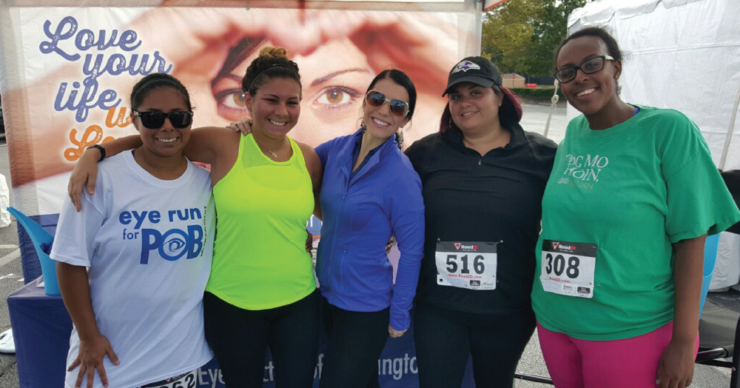
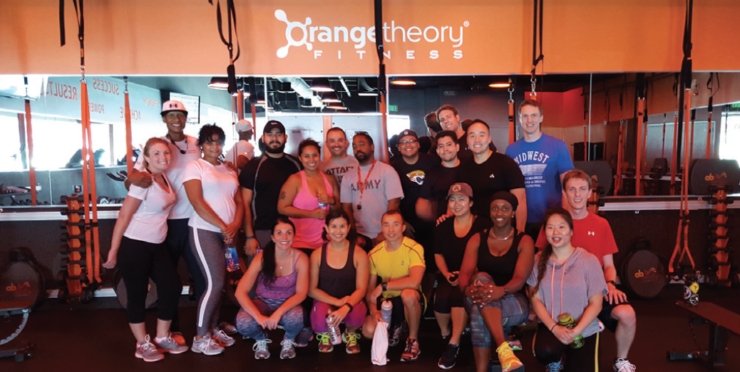
CRST: Standard protocols are integral to EDOW’s success. Explain their role.
Dr. Kang: When you have multiple providers and multiple locations, it’s important to build a brand. There has to be consistency among the providers and locations. The analogy I always give our employees is, if you order a caramel macchiato at Starbucks, it should taste the same whether it’s from a Starbucks in downtown DC or in Maryland. The same is true for health care. Within our practice, we aim to approach cataracts, dry eye, or glaucoma with the same game plan in an effort to minimize variability. That’s the way a brand is built. Consistency is the way to avoid having people who only want to see a particular doctor in a particular location. They know they can count on all of us to provide a fantastic experience across the board, and this goes beyond the clinical and surgical protocols. In order to achieve that overall experience, you need consistency in the practice’s messaging, in the delivery of care, and [in] every other aspect, even down to documentation and billing. All of those things require careful consideration and a group mentality.
CRST: Give an example of how you minimize variability and achieve a group mentality.
Dr. Kang: Let’s look at the cataract evaluation process. We have established very specific protocols and workflows that are the Eye Doctors of Washington’s recipe for cataract evaluation.
Before we establish [a] standard, all of the doctors discuss it and come to an agreement. Then, we present it to all the technicians, who have to review this protocol and sign off that they agree to follow it. Then, we have a head technician who regularly audits patient charts to make sure that that’s the way it happens. If someone wants to make a change, [he or she has] to go through the process and get agreement and then change the main template. You can’t just freelance and make small adjustments here and there. That’s how you ensure that every technician, whether he or she is new or has been on staff for years, understands; [he or she is] trained to the Eye Doctors of Washington way, and that creates a cultural mindset. If you invest in your staff’s understanding why you do what you do, and it’s very explicitly spelled out, you can develop a culture where you are delivering consistent, high-quality care.
An equally important part of this process is ensuring consistency when implementing new technology. When we integrate new technology, the messaging and the way we integrate it has to be well thought out across the board. When we integrated laser cataract surgery, we did our research, and we felt very [sure] about the technology. We then trained our staff and all of the doctors to be on the same page. We were very transparent [about] what we thought, and all of that messaging was then shared on our website. Everything was planned out and consistent. That’s how you avoid different factions and techniques within a practice.
Digital Outreach—It Takes a Village
Paul Kang, MD, his partners, and their administrative staff spent a lot of time fine-tuning Eye Doctors of Washington’s brand—one where patients know they can expect the newest and best technology and a cadre of surgeons with the expertise to use that technology to achieve top-notch results. Once you develop a brand, says Dr. Kang, “you have to do the work to maintain it, or let the chips fall where they may.”
Today, that includes establishing and maintaining a digital presence and gaining a healthy knowledge of search engine optimization to ensure that, when prospective patients look for eye care or eye surgery, the practice will appear high up in the search. It also means that, when a patient with an axe to grind posts a negative review about the practice, there will already be so many positive comments that the impact of the negative one will be diluted.
“We were very hands-on from the beginning, and we became very familiar with how social media works, and with [search engine optimization], we quickly gained a healthy respect for it,” explains Dr. Kang. “As time went on, however, and social media grew into an integral part of how people communicate, we realized it was beyond what we could do in our spare time. This is something that needs dedicated resources. We hired a service, but I’m still very involved, and we also have people in house who monitor all of our digital initiatives and interface with the service.”
Monitoring online reviews is key to maintaining the integrity of the brand. “It’s something that’s extremely important to us, and we push hard to get patients to review us,” says Dr. Kang. That means training staff to actively ask for it. “When patients say they had a great experience, it takes just a couple of moments to say, ‘Would you mind sharing that online?’” he says. “That’s one step. Then, the next step is to monitor it to see how effective our efforts are.”
After putting that much effort into establishing an effective online presence, says Dr. Kang, the nice thing is that the growth comes accordingly. “When the patients start to come in, they’re better educated because they know all about us, they’ve been to our website, and they’ve read the reviews,” he says. “The people who come to you through social media are more likely to write reviews, too. So, these are patients who are following us on Twitter and [liking] us on Facebook, and this generates even more patients. I think it’s nice to have a patient who comes into your office and already feels he or she knows what to expect. [He or she] know[s] it’s going to be a great experience, and we just have to make sure that we deliver upon that expectation.”
CRST: Consistency is key to the EDOW culture, but each site is somewhat different. How does EDOW address this?
Mr. Conte: All five of our locations are relatively close together, with our main office just down the street from the White House and our farthest two offices … just 13 miles apart. Despite their proximity, they each have a somewhat distinct demographic population, and in response to that, each of our locations has its own unique personality. For instance, our Chevy Chase location caters to an older patient base, where we treat a lot of cataracts, whereas our main DC location has a very young, technology-driven patient population, where we see more LASIK patients.
With respect to this, we try to be everything to everyone but in a very subtle way. For instance, we have electronic patient check-in kiosks at each location, but in the Chevy Chase office, where we see mostly Medicare-aged patients, they are asked to key in answers to basic check-in questions to get them through the kiosk as quickly as possible, whereas in our DC office, we’re more comfortable asking a few extra marketing questions such as “Where did you hear about us?” and “What’s your email address?” and “Do you want to opt in for text messaging?” Basically, we try to use technology to cater best to the demographic in each location.
CRST: Is there anything else about EDOW’s location that plays into its success?
Mr. Conte: The recession made it difficult to maintain growth, especially around LASIK, in many areas of the country. Having offices in and around DC insulated us somewhat, as employment remained steady here.
CRST: What is EDOW’s role in the community beyond being a provider of cutting-edge eye care?
Dr. Kang: We’re active in a lot of different charitable events such as the Prevention of Blindness 5K, where oftentimes the entire staff will participate. We have a vibrant young staff, and when they express interest in participating in these events, we’re happy to sponsor them, buy the tee shirts, and pay the entry fees. We also do a lot with the local professional sports teams. We’re the eye doctors for the Washington Capitals (NHL), the Wizards (NBA), and the Mystics (WNBA).
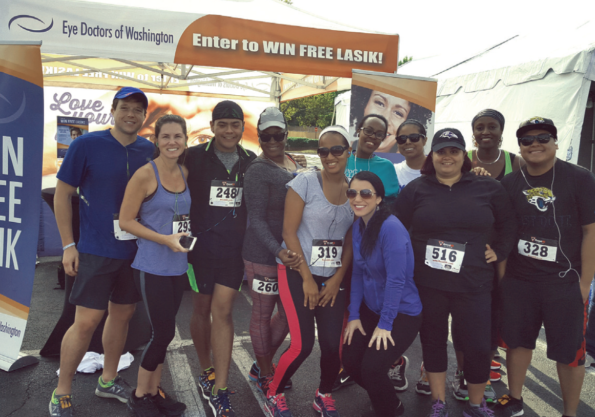
CRST: How significant a role does LASIK play at EDOW?
Mr. Conte: It plays a pretty big role, bringing in approximately one-third of our overall revenue. We had small but steady growth in our LASIK numbers of 3% to 5%, even during the economic slowdown. The way we provide LASIK and how we market it in this practice are very simple, and I think that helps. We offer one laser platform, the Alcon EX500 and FS200 suite, which we consider the best currently available. We were very early adopters of that technology—just sixth in the nation to get the FS200—and we were one of the first to get the 500-Hz laser. By being early adopters, we can confidently tell our patients we’ve got the latest and greatest technology and that this is all we offer because it’s the best. Doing that simplifies the message and helps us keep our prices competitive.
CRST: Is there anything in particular that you think has played a significant role in the practice’s success?
Mr. Conte: Beyond the obvious—the best doctors, staff, and technology—I think social media has had a huge impact, especially among the younger demographic. They’ve already done their research, and they come in already having an idea of what their disease state might be. We think it’s important to use social media as a platform to educate the patients. If we can do that, and we can offer them useful information, and that pushes them back to our website, and we’re seen by them as experts, then it really helps to make the provider choice easier for the patients. By no means do I think we are experts at using social media at this point, but the more we learn about it, the more value we derive from it.
CRST: What is your trick for maintaining steady growth?
Mr. Conte: We’ve spread ourselves out and diversified so that, even if LASIK volumes dip, we’re able to continue to grow, because we’re not dependent on just one subspecialty or one ophthalmic procedure. For instance, our glaucoma specialists have been doing the iStent Trabecular Micro-Bypass Stent procedure [Glaukos], and that helps to bring in a different patient population. Diversification helps build our brand, bring revenue, and strengthen the bottom line.
CRST: What would you say makes the practice excellent?
Mr. Conte: Our surgical expertise is excellent. Beyond that, I think the thing that makes us special is our customer service. We hire good people, and we empower them to make the patient experience top-notch. When a practice grows as fast as [ours has] over the past 8 years, you’ve got to be able to make sure that everybody is moving ahead with the same mission. Sometimes, it’s extremely difficult to do. Sometimes, we have setbacks. No matter what, we roll out the proverbial red carpet for patients, and we make sure the patient experience is one that they will talk about positively. We make sure they walk out smiling, and that is reflected in the fact that our biggest referral base [consists of] friends and family.




